I sometimes forget the prevailing notions people have related to growing food. The most common mental images seem to center around long hours of back breaking labor spent tilling, planting, hoeing and weeding.I am quickly reminded of the current thinking when I breezily say things like, "I planted 288 spinach plants today and need to do the same for lettuce tomorrow." and the person I am speaking with gapes in horror at the perceived amount of time and effort that goes into it. But the chasm between what they are thinking and what I actually did is as big as the Grand Canyon. We are operating under two VERY different paradigms when it comes to growing food...Depending on the agricultural model used, growing food can be relatively low-labor and the little time and money spent in the garden is subtracted directly from the time and money that would otherwise be spent driving to the grocery store, finding produce that is less nutritious and fresh, waiting in the checkout line to pay and then driving home on a daily or weekly basis.This morning I planted 36 Red Romaine lettuces and the whole process took about 20 minutes. I started with a homemade plant spacing tool made from plywood, cheap cabinet handles and recycled wine corks: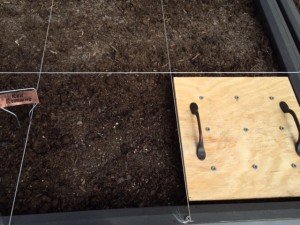
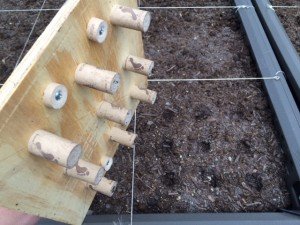 Lettuce can be planted 9 to a square foot so I pressed the spacer into 4 of my 1'x1' squares to leave divots where the seeds should be planted.Next I shook out some seed into my palm and placed 2 per divot. I normally have really good germination rates with the Baker Creek lettuce seeds, but these are last year's seeds so I did 2 to be safe. This was the most time intensive part of the whole operation but not what I would call laborious.
Lettuce can be planted 9 to a square foot so I pressed the spacer into 4 of my 1'x1' squares to leave divots where the seeds should be planted.Next I shook out some seed into my palm and placed 2 per divot. I normally have really good germination rates with the Baker Creek lettuce seeds, but these are last year's seeds so I did 2 to be safe. This was the most time intensive part of the whole operation but not what I would call laborious. When I was done I patted the soil over the seeds, lightly covering them and creating good dirt to seed contact then watered.
When I was done I patted the soil over the seeds, lightly covering them and creating good dirt to seed contact then watered.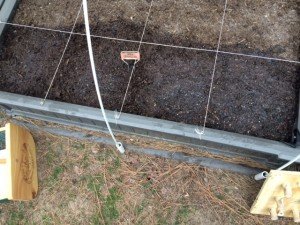 Voila!Yes there will be some watering throughout the season and yes, I do get an occasional volunteer plant that needs to be plucked out of my garden beds, but those are minor things, easily taken care of when I head out to my backyard grocery store each night and look around to see what's for dinner.
Voila!Yes there will be some watering throughout the season and yes, I do get an occasional volunteer plant that needs to be plucked out of my garden beds, but those are minor things, easily taken care of when I head out to my backyard grocery store each night and look around to see what's for dinner.
Don't Blink
During the past week of business travel my indoor plant starts have grown with the vigor of youth into a verdant and slightly unruly bunch of tweens.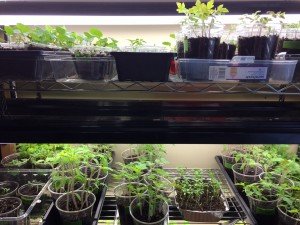 The tomatoes from my saved seed are particularly in need of thinning. I seeded them a little more thickly since I did not know what my germination rate would be. While they initially lagged about week behind fermented seeds I purchased this year, the germination rate for my saved seed looks to be close to 100%.
The tomatoes from my saved seed are particularly in need of thinning. I seeded them a little more thickly since I did not know what my germination rate would be. While they initially lagged about week behind fermented seeds I purchased this year, the germination rate for my saved seed looks to be close to 100%.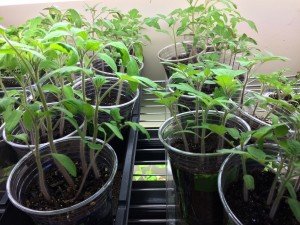 Pro Tip - always use scissors to snip off the plants you are thinning to avoid disturbing the roots of chosen specimen.
Pro Tip - always use scissors to snip off the plants you are thinning to avoid disturbing the roots of chosen specimen.
Tender Beginnings
While winter is having it's (hopefully) last hurrah outside, I am prepping my indoor garden to be without me for a week while I travel for work.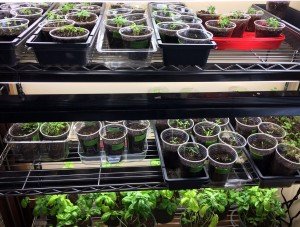 After trying first newspaper pots then peat pots for last year's starts and having them disintegrate before I was ready to transplant to the garden, this year I am using Siloé Oliveira's technique of drilling holes in smooth plastic cups that can be reused year after year.All of my starts are doing well but the ones I am happiest about are my saved seed from the Paste and Amana tomatoes I grew last year. They sprouted a few days behind the new varieties I purchased seed for this year, but since I did not ferment the saved seed I knew they would lag a bit.
After trying first newspaper pots then peat pots for last year's starts and having them disintegrate before I was ready to transplant to the garden, this year I am using Siloé Oliveira's technique of drilling holes in smooth plastic cups that can be reused year after year.All of my starts are doing well but the ones I am happiest about are my saved seed from the Paste and Amana tomatoes I grew last year. They sprouted a few days behind the new varieties I purchased seed for this year, but since I did not ferment the saved seed I knew they would lag a bit.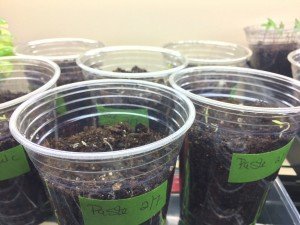 And gratuitous pics of some of the collards and other tomato varieties starts just because they are so pretty...
And gratuitous pics of some of the collards and other tomato varieties starts just because they are so pretty...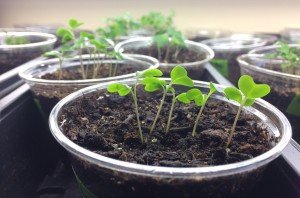
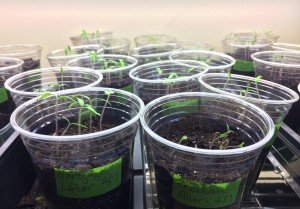
Starting My Garden Early
While Punxsutawney Phil and the meteorologists work out their differing predictions for the end of winter, growers are already hard at work preparing for spring, summer and fall.January plant starts included cabbage,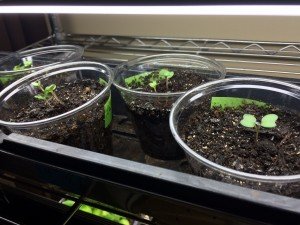 chili peppers, bell peppers and rosemary.
chili peppers, bell peppers and rosemary.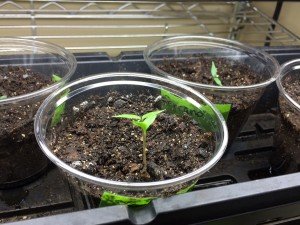 Now that February has begun, the seed starting kicks into high gear with oregano, collards and lots and lots of tomatoes with 8 varieties and a total of 38 plants this year!
Now that February has begun, the seed starting kicks into high gear with oregano, collards and lots and lots of tomatoes with 8 varieties and a total of 38 plants this year!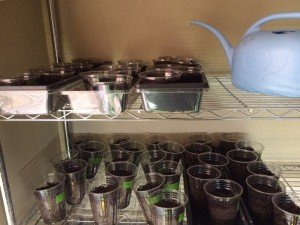 The new starts will welcome roommates in my growing nook for the cilantro and basil I grow indoors each winter. I purchased inexpensive shop lights, metal wire shelving units and florescent tubes 5 years ago so I never have to go a grey winter day without their bright colors and fresh flavors complimenting meals.
The new starts will welcome roommates in my growing nook for the cilantro and basil I grow indoors each winter. I purchased inexpensive shop lights, metal wire shelving units and florescent tubes 5 years ago so I never have to go a grey winter day without their bright colors and fresh flavors complimenting meals.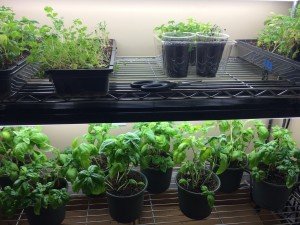 The minimal, initial investment for the equipment has more than paid for itself already and now as my garden diversifies and the number of indoor starts continue to expand each year with no additional infrastructure costs to date, I consider this money extremely well spent.Happy Spring, whenever it comes :)
The minimal, initial investment for the equipment has more than paid for itself already and now as my garden diversifies and the number of indoor starts continue to expand each year with no additional infrastructure costs to date, I consider this money extremely well spent.Happy Spring, whenever it comes :)